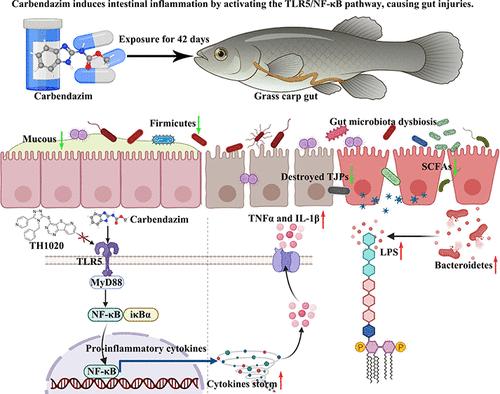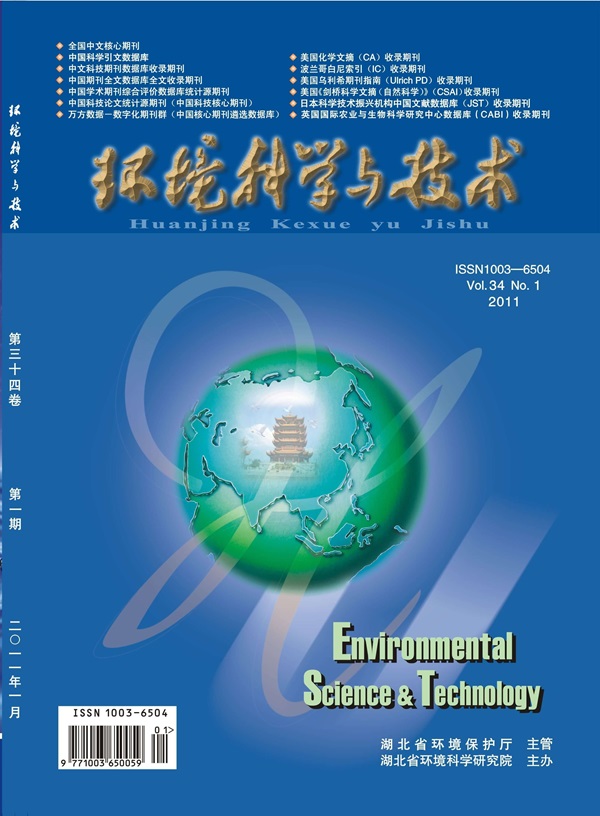Benzimidazole Fungicide Carbendazim Induces Gut Inflammation through the TLR5/NF-κB Pathway in Grass Carp
IF 10.8
1区 环境科学与生态学
Q1 ENGINEERING, ENVIRONMENTAL
引用次数: 0
Abstract
Fungicides have been increasingly used across various sectors, including agriculture and textiles. The biocidal properties of fungicides may negatively impact the stability of intestinal microbiota, thereby posing a threat to intestinal health. In this study, we investigated the mechanisms of intestinal damage and functional abnormalities in grass carp following a 42-day exposure to the widely used fungicide carbendazim at environmentally relevant concentrations (0.2 to 20 μg/L). Histopathological observations, mRNA and protein expression analyses, biochemical analysis, quantification of short-chain fatty acids (SCFAs), cytokines, lipopolysaccharide (LPS), and 16S ribosomal ribonucleic acid (rRNA), as well as internal transcribed spacer (ITS) sequencing, were performed. At environmentally relevant concentrations, carbendazim strongly induced intestinal inflammation, leading to increased transcriptional and translational levels of genes involved in the toll-like receptor five (TLR5)/nuclear factor kappa B (NF-κB) pathway, including TLR5, NF-κB, interleukin-1 beta (IL-1β), and tumor necrosis factor-alpha (TNFα). Additionally, carbendazim damaged intestinal barriers and reduced the expression of tight junction proteins (e.g., occludin and zonula occludens-1/2), goblet cells, and immunoglobulin M levels, while also disrupting the gut microbiome, leading to intestinal metabolic disorders, particularly decreases in SCFAs and increases in LPS. Treatment with the TLR5 antagonist TH1020 mitigated intestinal inflammation caused by carbendazim, subsequently improving mechanical barrier function. Overall, our findings provide new insights into the toxicological mechanisms underlying intestinal damage caused by carbendazim in grass carp, indicating that carbendazim poses a significant threat to nontarget organisms. Given its widespread detection in the environment, these results underscore the substantial ecological risks to the gut health of fish living in carbendazim-contaminated water bodies.

求助全文
约1分钟内获得全文
求助全文
来源期刊

环境科学与技术
环境科学-工程:环境
CiteScore
17.50
自引率
9.60%
发文量
12359
审稿时长
2.8 months
期刊介绍:
Environmental Science & Technology (ES&T) is a co-sponsored academic and technical magazine by the Hubei Provincial Environmental Protection Bureau and the Hubei Provincial Academy of Environmental Sciences.
Environmental Science & Technology (ES&T) holds the status of Chinese core journals, scientific papers source journals of China, Chinese Science Citation Database source journals, and Chinese Academic Journal Comprehensive Evaluation Database source journals. This publication focuses on the academic field of environmental protection, featuring articles related to environmental protection and technical advancements.
 求助内容:
求助内容: 应助结果提醒方式:
应助结果提醒方式:


